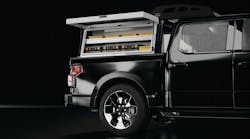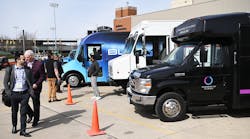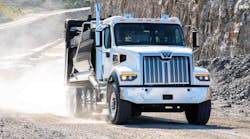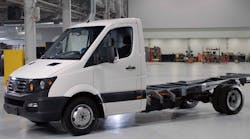BOB Aquaro has sold all over the world. It doesn't matter whether it's Mongolia or Mexico: People have the same questions and the same problems, and are looking for the same solutions.
“There are cultural differences between markets,” he said. “You don't necessarily sell the same way in every market, but it comes down to this: People buy from people. End of story. People buy from people they like. People buy from people they're comfortable with. And most importantly, they buy from people they trust.
“Trust is the biggest factor. If I don't trust you, I don't buy from you. And guess what questions people ask in other countries? How do I hold the profit? The same questions you guys ask. What do I do to create value?
“I've spent a life of travel in many different places and cultures, but the same thing goes down in the bottom line. They buy from companies they trust, from businesses they trust, from manufacturers they trust.”
In his day-long seminar, “Selling skills for Truck Body and Equipment professionals,” Aquaro — president of Tara Commercial Vehicle Consulting Services — said he once read in a book that “just because you have a great idea, product, or service and a well-laid-out proposal doesn't mean that you can sell it.”
He questions that thinking, because he believes everyone sells something to someone. He said an idea or concept is the hardest thing to sell because it is intangible that can't be touched.
“Always consider the level of sophistication of your product and thus the sophistication of your customer,” he said. “Are you at their level? Are you suitably prepared?”
He said there are four essential steps:
• Sell yourself first, with no attitude.
“You are the most important part of the deal. You must establish customer confidence and trust. You do this by knowing what you are talking about. You are prepared. We don’t prep enough. We don’t research thoroughly. You should know as much about your customers’ business as possible before your first sales meeting.
“At the first sales meeting, you will validate your information and you will learn new information that will affect the negotiation process.
“Do you know who you are talking to? Company president? Engineer? Purchasing agent? A person with absolutely no purchasing power? Always speak from a position of authority. You are an expert on this subject and can solve Mr Customer’s problem. Build enthusiasm in the customer’s mind. Begin to create value. You are value. You never say, ‘I will have to talk that over with my boss and get back to you.’ You say, ‘Mr Customer, I will have to study your proposal to decide if this is a profitable/sound decision for my company as well as yours.’
“At your first meeting with Mr Customer, walk into the room like you own it. Make eye contact, give a firm handshake, exchange cards, and immediately start taking notes. Interview your customer, ask questions, and wait for answers. When referring to your company, it is ‘we’ and ‘our,’ not they.
“If you can, dress like them. Ask, ‘What is their office dress style?’ If you don’t know and cannot find out, a tie and jacket can never be wrong. Needless to say, grooming is important. Be cognizant of your overall appearance. Are tats socially acceptable? First impressions count: It is best to be 45 to 50. It’s a neutral age.
“There an ‘Age Perception’ perception: ‘Young people talk too much.’ ‘Young people don’t listen to what I am saying.’ Listen, take notes. Build enthusiasm and create value. Being practical solves a problem. Being emotional doesn’t really solve a problem, and it may actually cause a problem.
“If you have never met the customer, immediately start evaluating his or her personality type: Driver would be the president, senior management, VP. Analytical would be an engineer, CFO, CPA, service guy. Expressive means talking, stories, friendly. Amiable means quiet, shy, polite. There is an effect of personality on sales success: Ten people are going to buy a product. You will sell two of them easily, comfortably. You will never sell two of them—ever. What you do with the remaining ones will determine your success. That‘s your closing rate.
“Can you come out of your Comfort Zone? How well do you know yourself? Use your head. If you are having a sales lunch with Pepsi, don’t order a Coke! If you are quoting to UPS, don’t send the overnight bid via FedEx! If you are visiting Ford, don’t show up in a Chevy, and then take the Ford guys to lunch and offer to drive!”
• Sell your company second.
“Say, ‘Mr Customer, I would like to tell you a little about my company, Tara CVCS, Inc. Trust is important. Are you a ‘Distributor Member’ of NTEA or a ‘Manufacturer Member’? There is a difference in the way you present your company. As a ‘Distributor Member,’ you are selling two companies. You should proceed to sell your company first. You should hold off selling your ‘represented company’ until the sell-your-product phase.
“What is the question I want to answer first? My first question that I want answered is: ‘Do we have any history with these guys? Is that history good or bad?’ If good, great. Then make sure we keep them. If bad, how do we fix it right up front? Know the history; walk in with the solution.
“Answer three questions right up front: ‘Why should I buy this from you?’ ‘Why should I buy it from your company?’ ‘Why should I give you X-number of dollars that I have to work very hard for?’
“A special note for those of you selling import products. The Big Three objections are: cost and delivery; parts supply; and service technician training. What are your company’s ‘Pillars of Strength’? Do these qualities and attributes create value? Is this not what the customer buys? So far, your value and your company’s value have been identified and fortified. The value is not the price.
“Final thought: How well do you know your competition?”
• Sell your product third.
“Product training is not your bosses’ responsibility. Generally the manufacturer of the product does a pretty good job. Hands-on training beats the Internet every time. Know as much as you can about your competition.
“A word about competitive analysis. It must be factual. It should be value-oriented. Stated claims must be substantiated. What you say can and will be held against you.
“Carroll Shelby (the American auto designer and entrepreneur) said, ‘If the product is good, the name won’t matter. If the product is bad, the name won’t help it.’
“Demonstrations are a great opportunity to get to the real user of the product. Need a truck? Find a co-operative truck dealer. Chambers of Commerce lunches or dinners. User groups functions.
“Working with truck dealers can be a mutually beneficial relationship. Most problems are the result of not putting agreements in writing—very poor documentation. The specs are right, dimensions are wrong. The salesperson may not be knowledgeable.
“In working with truck manufacturers, the name on the front of the truck is most likely not yours. They do not want to be between a rock and a hard place. They cannot violate regulations, and that includes all FMVSS, EPA, CMVSA, DOT, CARB, OSHA, NASA, and NUMA regulations.
• Then present your price, and be prepared to negotiate.
“Presentation of the proposal involves discussion, negotiation, adjustments/clarification, and the close.
“Discussion: Do not be afraid to talk. Give talking points backed up in writing. It’s necessary for an explanation of the proposal. Present dialogue to clear up points: friendly, civil, stated matter of factly.
“A price objection means that Mr Customer has not yet realized the created value. Price objections often are merely an easy way out. They mask the real objection. There’s an important note about your price: Start by offering the right product in the first place. Quote what Mr Customer needs; not more and certainly not less. If you conducted a proper interview with Mr Customer, you know what he needs. It may not be what he wants.
“Negotiation is also known as, ‘Oh, crap.’ First of all, is there such a thing as a win-win negotiation? Yes! You can negotiate a win-win situation. It takes two willing people. If one person is willing, and the more aggressive personality is secretly not willing to ‘lose’, it will not happen. I really never liked it when people said this is a win-win situation.
“Knowledge Point #1: Who is in what position? Are you in a position of strength? Are you in a position of weakness? Is the customer in a position of strength? Is the customer in a position of weakness?
“Knowledge Point #2: Your range. Based somewhat on your position, you will decide to make an aggressive offer or to make a weak offer. You have estimated the range of agreement that you believe will be the closing point of this sale. An aggressive offer can result in getting kicked out of Mr Customer’s office. However, what is aggressive in your mind may not be aggressive in Mr Customer’s mind.
“Have you justified the aggressive offer? Did you sell yourself? Sell your company? Create enthusiasm about your product? Create value? Or just claim valve? If the customer shows shock, be prepared to offer more value without reducing your price. But do what you say you will do. Aggressive offers require confidence and planning. You need to know why you are making this aggressive offer. A weak offer can cost you money. When the customer jumps up to hug you, you blew it.
“Knowledge Point #3: What is your fallback plan? What are your alternatives? What do these alternatives represent? Is there a final point of negotiation? What is your plan to leave?
“Knowledge Point #4: Walk away. What is the lowest offer you will accept? When does it make no sense to waste any more time? Have you calculated what this product is worth to this customer?
“Knowledge Point #5: Silence. When you present Mr Customer a proposal, give them a chance to read it. Do not talk while they are considering the proposal.
“Consider the value of this relationship. Consider the long-term value. Consider your reputation. Forgo short-term gains for long-term objectives. Negotiation does not mean that someone wins and someone else loses. Both parties must receive value. Negotiation does not mean that one party alone must compromise.”
Building Your Sales Base
He said there are hundreds of ways to find customers.
“How hard do you want to work?” he asked. “What do I believe is the least effective way to find customers? Cold calling. Unless you are doing a sales ‘blitz.’
“What is your best, maybe easiest, lead source? Lost customers. Current customers. Prospecting is a significantly productive use of time. Cold calling is a waste of time and energy.”
He said the best method of prospecting isn’t just buying lists, unless you are going to use them. He said you must set milestones and do research: Who do you want to sell to?
“Plan how to proceed,” he said. “Talk to non-competing companies who sell that company. Prepare by investigating. Gain useful information. Determine what is attainable and not pie in the sky. What is realistic? Do you really think you have a chance? Is there an incumbent? What is it going to cost my company to secure this customer?”
He said a prospecting seminar is informative, educational, focused, and very personal.
“It offers real customers information that helps them save money using the latest and greatest products out there,” he said. “It’s organized into sessions where speakers are invited to present various products that your company offers. It is always on a Friday, always starts at noon, always includes lunch, and always offers a scheduled format. It is never until some predetermined time. It always includes an incentive—a door prize. If you are a distributor, you will always have representatives from your manufacturers present.
“It is a boatload of work because it requires complete follow-through by staff who care if people show up. Follow-up and follow-through are mandatory, or don’t even bother.”
He said advertising involves developing an Internet presence through a newsletter.
“What is a hard, fast rule of advertising? Consistency,” he said. “You sell truck equipment. Not everyone owns a commercial vehicle. You need to get to those that do.
“A specific purpose of the newsletter is to keep your name in front of the customer. It should take no more than five minutes to scan it. It must contain at least one news article and be informative. It can highlight an employee accomplishment or announce a sale, or a change in something—maybe new hours on Saturday.”
With direct mail, he said, results are based on the number of mailings, with a 2% return being considered great.
“The quality of the mailer is vital,” he said. “Offer a promotion of some kind—a discount or sale, a reason to want to read it.
“To whom do you mail? Buy lists, yes. Join user groups and contact trade associations for lists of trade show attendees. The biggest errors are expecting too much from one mailing and not following up your mailings with calls. This is a form of advertising. Consistency is key. You have to make this a scheduled task.”
After all this, now what?
“You have to ask for the sale,” he said. “That’s very hard for some people to do. With driver personalities, it’s pretty easy. With amiable personalities, not so easy. The College Close goes like this: ‘My kid’s tuition is due, and if I don’t make this sale, he is going to get kicked out of school.’ The My-Wife-is-Pregnant Close: ‘Chrissie is due with our twins next month, and if I don’t close this deal, I am going to lose my medical benefits.’
“Or you can read books. Brian Tracy’s The Art of Closing. Zig Ziglar’s The Secrets of Closing. Tom Hopkins’ How to Close. I cannot tell you what will work for you. What worked for me was just making an asking statement: ‘Mr Johnson, I would be very proud to have your business. Let’s do this deal, sir.’
“You want this customer forever. You don’t want to sell them only one time. You do not want to work this hard the next time.”








